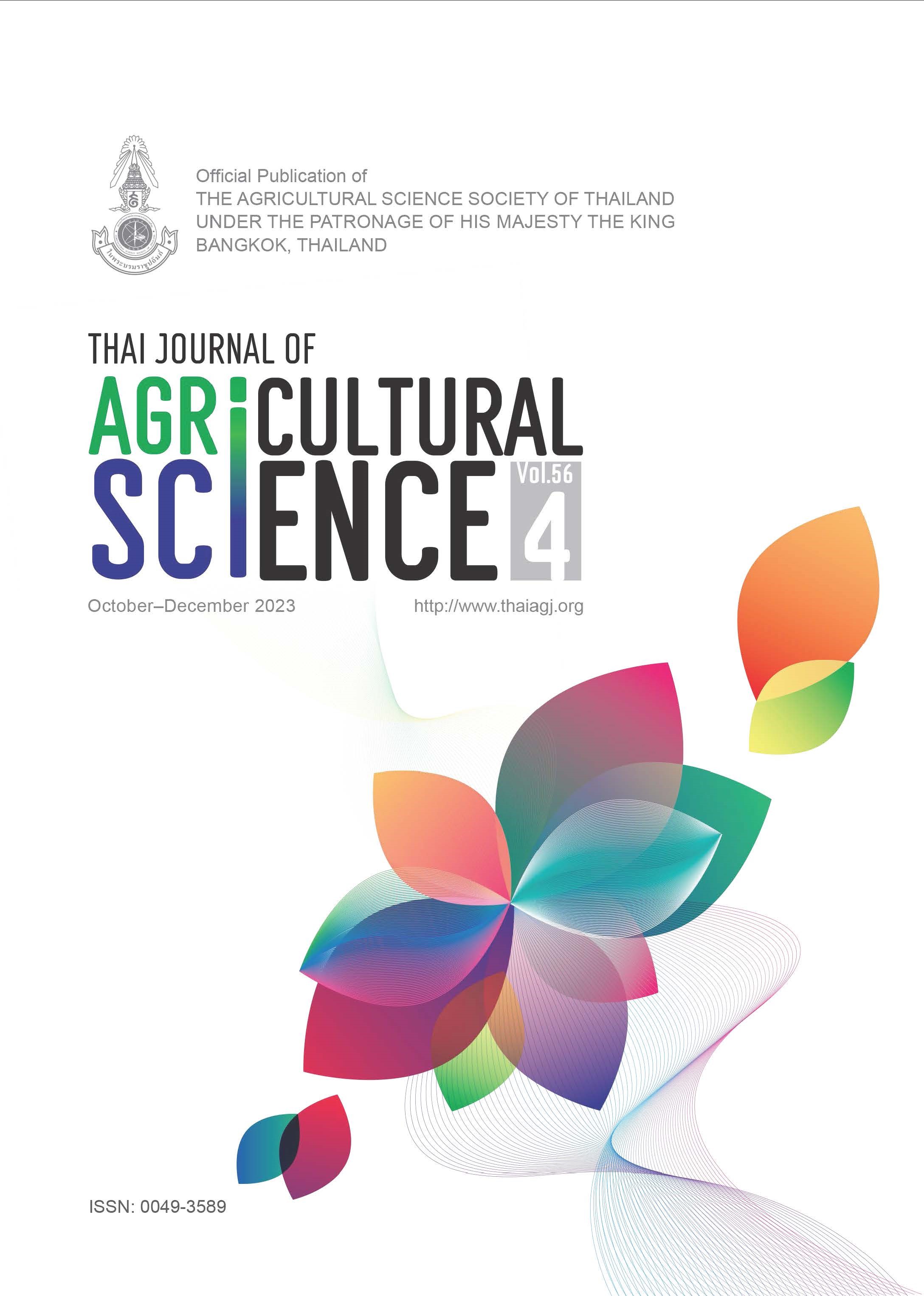Litter indices of primiparous rabbit does subjected to feed restriction during pregnancy with or without vitamin E inclusion
Main Article Content
Abstract
Background and Objectives: Rabbits are characterized by high reproductive efficiency (number of offspring produced per doe per annum). Excessive overweight in rabbits has been reported to impair reproductive efficiency. Therefore, different feeding strategies have been explored to maintain body conditions of does. Thus, this study evaluates litter indices of rabbits does subject to feed restriction during pregnancy with or without vitamin E inclusion.
Methodology: Seventy-five (75) rabbits consisting of 60 primiparous rabbit does of 5 months old (1.7–2.0 kg) and 15 mature bucks of 6–7 months old, of mixed breeds (Chinchilla, Dutch, and New Zealand White) were randomly assigned into 12 treatments of 5 replicates each. Rabbit does were placed on two levels of quantitative feed restriction (0 and 15%) at three gestation periods (15–19, 20–24, and 25–29 days) with or without vitamin E inclusion (0 and 300 mg/kg). Data obtained on litter indices were subjected to a three-way analysis of variance in a completely randomized design.
Main Results: The overall interactive effect shows that significantly (P = 0.04), the highest average litter weight at birth, 354 ± 78.8 g was obtained from does fed ad libitum with vitamin E inclusion at 15–19 days compared to other treatments. The higher weight of kits at birth was obtained from rabbit does fed ad libitum with vitamin E inclusion for 15–19 (61.06 ± 0.32 g), 20–24 (62.03 ± 8.56 g), and 25–29 (60.86 ± 0.34 g) days compared to other treatments. While litter weight at weaning was statistically (P = 0.03) highest (3,170 ± 214 g) from rabbit does on feed restriction with vitamin E inclusion at 15–19 days of gestation.
Conclusions: Ad libitum feeding with vitamin E inclusion during pregnancy resulted in higher litter weight and kit weight at birth than the restricted group. Therefore, for better kit weight and viability during kindling, vitamin E should be incorporated in the diet of pregnant rabbit does.
Article Details

This work is licensed under a Creative Commons Attribution-NonCommercial-NoDerivatives 4.0 International License.
References
Abdul-Khalek, A.M., N.A. Selim, Sh.A. El-Medany and S.A. Nada. 2008. Response of doe rabbits to dietary antioxidant vitamins E and C during pregnancy and lactation, pp. 519–524. In: Proceedings of the 9th World Rabbit Congress. Verona, Italy.
Bass, R.T. 1999. Effects of Vitamin E Supplementation in Late Gestation Cattle and Evaluation of Vitamin E, Cholesterol, and Phospholipid Relationships in Bovine Serum and Serum Lipoproteins. PhD Thesis, Virginia Polytechnic Institute and State University, Virginia, USA.
Bowen, R. 2003. Vitamin E. VIVO Pathophysiology. Available Source: http://www.vivo.colostate.edu/hbooks/pathphys/topics/vitamine.html. December 9, 2023.
Brecchia, G., L. Menchetti, R. Cardinali, A. Polisca, A. Troisi, M. Maranesi and C. Boiti. 2012. Effects of fasting during pregnancy in rabbit does, pp. 341–345. In: Proceedings of the 10th World Rabbit Congress. Sheikh, Egypt.
Di Meo, C., F. Bovera, S. Marono, N. Vella and A. Nizza. 2007. Effect of feed restriction on performance and feed digestibility in rabbits. Ital. J. Anim. Sci. 6(suppl. 1): 765–767. https://doi.org/10.4081/ijas.2007.1s.765.
Fortun-Lamothe, L. and F. Lebas. 1994. Effect of the level and origin of dietary energy on reproduction performance of primiparous simultaneously pregnant and lactating rabbit does. Journées de la Recherche Cunicole. 2: 285–292.
Fortun-Lamothe, L. and F. Lebas. 1996. Effects of dietary energy level and source on foetal development and energy balance in concurrently pregnant and lactating primiparous rabbit does. Anim. Sci. 62(3): 615–620. https://doi.org/10.1017/S135772980001, 5174.
Google Earth. 2015. Federal University of Agriculture, Abeokuta. Available Source: https://earth.google.com/web/@7.22330744,3.44033719,137.84884575a,1046.69760578d,35y,100.57030218h,44.999997 06t,-0r/data=Cm4abBJmCiUweDEwM. March 1, 2015.
Gy, V., E. Cs, T. Tóth and J. Schmidt. 2008. Colour and pH of rabbit meat and fat deposits as affected by the source and dose of dietary vitamin E supplementation, pp. 1467–1471. In: Proceedings of the 9th World Rabbit Congress. Verona, Italy.
Hartmann, J. and J. Petersen. 1995. Vergleichende Untersuchungen zur Reproduktionsleistung von während der Aufzuchtphase restrectiv und adlibitum gefütterten Zuchthäsinnen, pp. 97–105. In: Proceedings of the 9th Symposium on Housing and Diseases of Rabbits. Celle, Germany.
Maertens, L. 1992. Rabbit nutrition and feeding: A review of some recent developments. Journal of Applied Rabbit Research. 15: 889–890.
Manal, A.F., M.A. Tony and O.H. Ezzo. 2010. Feed restriction of pregnant nulliparous rabbit does: Consequences on reproductive performance and maternal behaviour. Anim. Reprod. Sci. 120(1–4): 179–186. https://doi.org/10.1016/j.anireprosci.2010.03.010.
Menchetti, L., G. Brecchia, R. Cardinali, A. Polisca and C. Boiti 2015. Feed restriction during pregnancy: Effects on body condition and productive performance of primiparous rabbit does. World Rabbit Sci. 23(1): 1–8. https://doi.org/10.4995/wrs.2015.1703.
Mosaad Abd Elfatah, A.E. 2001. Some Physiological and Nutritional Studies on Productive and Reproductive Performance of New Zealand White Rabbit under Egyptian Condition. MS Thesis, Al-Azhar University, Cairo, Egypt.
Nafeaa, A., S.A.E. Ahmed and S.F. Hallah. 2011. Effect of feed restriction during pregnancy on performance and productivity of New Zealand White rabbit does. Vet. Med. Int. 2011: 839737. https://doi.org/10.4061%2F2011%2F839737.
Parigi Bini, R. and G. Xiccato. 1998. Energy metabolism and requirements, pp. 103–131. In: C. De Blas and J. Wiseman, (Eds.), The Nutrition of the Rabbit. CABI Publishing, Wallingford, UK.
Partridge, G.G., Y. Daniels and R.A. Fordyce. 1986. The effects of energy intake during pregnancy in doe rabbits on pup birth weight, milk output and maternal body composition change in the ensuring lactation. J. Agric. Sci. 107(3): 697–708. https://doi.org/10.1017/S0021859600069859.
Rommers, J.M., R. Meijerhof, J.P.T.M. Noordhuizen and B. Kemp. 2004. The effect of level of feeding in early gestation on reproductive success in young rabbit does. Anim. Reprod. Sci. 81: 151–158. https://doi.org/10.1016/j.anireprosci.2003.09.001.
Shaibu, G.A. 2014. Effect of Selenium and Vitamin E on Reproductive Performance of Rabbit Does and Kits. PGD Project. University of Nigeria, Enugu State, Nigeria.


